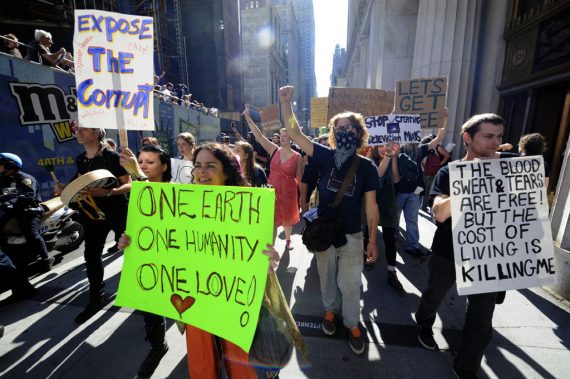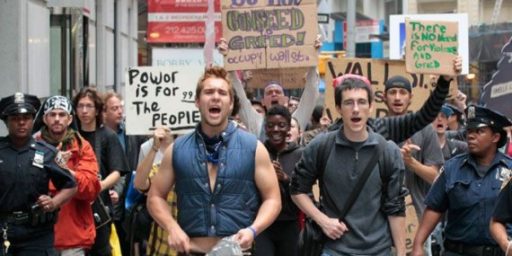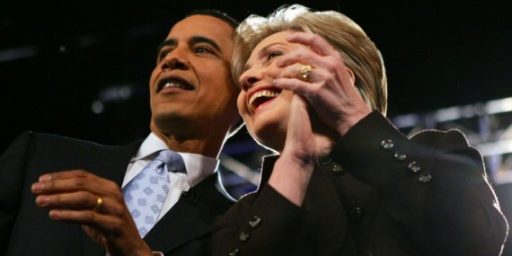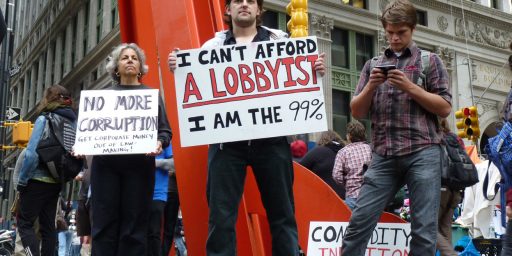Occupy Wall Street Outside The Mainstream?
Does "Occupy Wall Street" really represent the people they claim to be speaking for?
As Steven Taylor has already noted today, there’s a lot of discussion going on in political circles right now trying to understand what the whole “Occupy” movement is all about, what motivates, and what it means politically. As I noted yesterday, there is an element of the phenomenon, focusing as it does on the interactions between a government that is too big and spends too much and the businesses that seek to profit from that, that has merit. At times, though, it also seems like much of what we’re seeing from this movement isn’t all that different from the leftist/anarchist groups that used to tie up traffic in D.C. and other world capitals protesting the World Bank and the IMF, not to mention a rehash of may of the same left-wing diatribes against capitalism we’ve been hearing for decades now. The truth, perhaps, lies somewhere in between.
In an effort to try to understand this movement, Democratic Pollster Douglas Schoen went down to the Occupy Wall Street protest and polled the participants. He came back with a warning for his fellow Democrats:
President Obama and the Democratic leadership are making a critical error in embracing the Occupy Wall Street movement—and it may cost them the 2012 election.
Last week, senior White House adviser David Plouffe said that “the protests you’re seeing are the same conversations people are having in living rooms and kitchens all across America. . . . People are frustrated by an economy that does not reward hard work and responsibility, where Wall Street and Main Street don’t seem to play by the same set of rules.” Nancy Pelosi and others have echoed the message.
Yet the Occupy Wall Street movement reflects values that are dangerously out of touch with the broad mass of the American people—and particularly with swing voters who are largely independent and have been trending away from the president since the debate over health-care reform.
The protesters have a distinct ideology and are bound by a deep commitment to radical left-wing policies. On Oct. 10 and 11, Arielle Alter Confino, a senior researcher at my polling firm, interviewed nearly 200 protesters in New York’s Zuccotti Park. Our findings probably represent the first systematic random sample of Occupy Wall Street opinion.
When I first heard about this piece this morning, I had doubts mostly because its not clear that whatever sample of people Schoen’s group had interviewed would be a representative sample of the people at Zuccotti Park, and it would seem hard to argue that they are necessarily a representative sample of the groups participating in similar protests in other parts of the country. Nonetheless, the post has generated plenty of discussion across the blogosphere, and the finding are interesting to say the least:
Our research shows clearly that the movement doesn’t represent unemployed America and is not ideologically diverse. Rather, it comprises an unrepresentative segment of the electorate that believes in radical redistribution of wealth, civil disobedience and, in some instances, violence. Half (52%) have participated in a political movement before, virtually all (98%) say they would support civil disobedience to achieve their goals, and nearly one-third (31%) would support violence to advance their agenda.
The vast majority of demonstrators are actually employed, and the proportion of protesters unemployed (15%) is within single digits of the national unemployment rate (9.1%)
An overwhelming majority of demonstrators supported Barack Obama in 2008. Now 51% disapprove of the president while 44% approve, and only 48% say they will vote to re-elect him in 2012, while at least a quarter won’t vote.
Fewer than one in three (32%) call themselves Democrats, while roughly the same proportion (33%) say they aren’t represented by any political party.
What binds a large majority of the protesters together—regardless of age, socioeconomic status or education—is a deep commitment to left-wing policies: opposition to free-market capitalism and support for radical redistribution of wealth, intense regulation of the private sector, and protectionist policies to keep American jobs from going overseas.
Sixty-five percent say that government has a moral responsibility to guarantee all citizens access to affordable health care, a college education, and a secure retirement—no matter the cost. By a large margin (77%-22%), they support raising taxes on the wealthiest Americans, but 58% oppose raising taxes for everybody, with only 36% in favor. And by a close margin, protesters are divided on whether the bank bailouts were necessary (49%) or unnecessary (51%).
Thus Occupy Wall Street is a group of engaged progressives who are disillusioned with the capitalist system and have a distinct activist orientation. Among the general public, by contrast, 41% of Americans self-identify as conservative, 36% as moderate, and only 21% as liberal. That’s why the Obama-Pelosi embrace of the movement could prove catastrophic for their party.
The reactions to Schoen’s Op-Ed are about what you would expect. On the right, it’s being seen as confirmation of what they already thought about Occupy Wall Street. On the left, there is rejection, the assertion that Schoen is mis-stating his own results, and an attempt to discredit Schoen by pointing out, for example, that he’s done work for Citibank. It’s worth noting, though, that Schoen’s findings are consistent with a smaller survey taken earlier in October by New York magazine, and also seems to jibe with the Nate Silver’s examination of the geography of the protests. Silver found that participation in the protests has been proportionally larger in the Western United States, and comments:
This could be due to a number of factors. Perhaps it has something to do with race, for instance. Cities where African-Americans make up a majority of the population, like Detroit, New Orleans and Cleveland, have tended to have underwhelming numbers of protesters and poorly organized Occupy groups. (There are plenty of those cities in the South, the Northeast and even the Midwest — but not really in the western United States).
Or maybe it has something to do with technology: Much of the organizational activity for the Occupy movement has taken place online, and the West Coast is particularly tech-savvy.
I suspect that more than anything, however, it reflects the politics of the protesters. Specifically, they tend to be more liberal than they are Democratic partisans. Take liberalism, subtract the Democratic Party, and the remainder might look something like Occupy Wall Street
The New York Times took a different approach than Schoen did, and at least outside New York City the common theme seems to be anger at the status quo:
PHOENIX — Ken Alandt’s guitar, which he covered with bumper stickers and waved in the air at the Occupy Phoenix protest on Monday, is a symbol of the movement itself — a mélange of disparate causes, all of which prompt his blood to boil.
Mr. Alandt, 53, an out-of-work stagehand and one of hundreds participating in Phoenix’s version of Occupy Wall Street, is furious that people are dying in foreign wars. He is angry that medical marijuana was still considered illegal despite Arizona voters’ approval of it. He is livid about his lot in life.
“Bro, I have been lied to so many times that I don’t know who to believe,” Mr. Alandt said. “All the world’s problems run downhill, and I’m at the bottom.”
Protesters have taken to the streets and parks in cities across America, and in foreign capitals to boot, all under the banner of the Occupy movement. But not every group that has embraced the name, nor every individual who answers its call, necessarily marches in the same contentious lockstep.
While the protesters seem united in feeling that the system is stacked against them, with the rules written to benefit the rich and the connected, they are also just as often angry about issues closer to home, like education and the local environment. Each gathering bubbles up from its own particular city’s stew of circumstances and grievances, and the protesters bring along their pantheons of saints and villains.
“Peace activists, indigenous rights activists, immigrant activists — they’re all here,” said Liz Hourican, 40, who belongs to the antiwar group Code Pink and was scrawling a message in pink chalk on a sidewalk in downtown Phoenix, calling on American troops to come home. “It may sound different to you, but it’s all the same. We’re all stepping up and saying something’s wrong.”
There may be no common manifesto or list of goals — something that has drawn criticism from both inside and outside the movement — but there is one common thread: anger. Some have looked for jobs for months; others have lost their homes to foreclosure. Angry, they all are.
“What brings me out here? Outrage — outrage with what’s going on in this country,” said Lucy Horwitz, 79, who participated in Occupy Los Angeles. “Right now, the first issue on my mind is that corporations can buy congressmen.”
(…)
The ad hoc nature of the protests led to some discord.
Jean Marie Simpson, an actor and peace activist, objected when her fellow demonstrators at Occupy Tucson surrounded a man who had assailed the movement, shouting at him and thrusting signs in his face. “I left disappointed and disillusioned,” she said of her fellow occupiers.
But the inclusive nature of the movement, many said, gave it its strength. In Occupy Los Angeles, mothers from Malibu gathered outside City Hall with homeless people who took advantage of the free food offered in a tent city that is growing by the day.
“Everyone is here for very separate reasons, and that’s one of the reasons that this movement works,” said Sam Agger, an Occupy Tucson participant.
Actually, it strikes me that a lack of unity beyond some generalized sense of anger and economic uncertainty is nowhere near enough for the creation of a movement that has a shot of having an impact on political discourse in this country. The Tea Party ultimately succeeded, I would submit, largely because it quickly became focused on a limited number of issues and limited goals. Primarily, of course, there was the debate over health care reform that started at nearly the same time that the Tea Party protests themselves were beginning. During the summer of 2009, that led to many highly contentious constituent town halls where opponents made their voices known, as well as protests of one kind or another in various parts of the country. Add into that mix the fact that the economy was not improving and that the stimulus package passed in February 2009 was not appearing to have any real impact on the economy, and you’ve got a perfect political storm in many respects. Had these factors not been present, it’s possible that the Tea Party would’ve fizzled out or remained too divided on what the “important issues” were to have any real impact on politics.
The “Occupy” movement faces the same problem, it seems. Remaining unfocused and appealing to the public’s general disdain with the political system, something which Americans of all ideological stripes seem to share at the moment, can only last for so long. At some point, the movement either has to focus on clear goals, or it will end up fading away into something similar to the anti-globalization and anti-war protests we used to see during the Bush Administration, both of which were dominated by groups on the far left of American politics. That seems to be what findings like those reported by Schoen, New York, and Silver are suggesting.







I think it’s important to differentiate between the protestors and the movement. Demonstrations attract, pretty much as a matter of course, a large contingent of malcontents, losers, and the usual suspects who’ll show up to protest any damn thing. And, naturally, TV cameras will look for the weirdest cats they can to interview and represent the movement.
While I think the discussion Steven points to notes some important differences between the two, OWS and the Tea Party are animated by similar frustrations and angst. Both attracted a lot of unsavory characters but their overall messages both had quite a bit of merit. How they translate into public policy is another matter–but the grievances are real and legitimate.
It’s sad that the dems have to be warned against accidentally embracing their own base’s policies.
And it says a lot about the sad state of the modern dems, and why a fair number on the left have no interest in supporting them as a party. Including me.
One thing is for sure: If you’re trying to “understand” OWS, you’re not part of OWS.
I went to a tea party protest in 2009, just to see what it was all about. What I saw appeared to be a lot of middle-class people, ranging in age from late twenties (with young children in tow) to what looked to be retirement age. What they all seemed to have in common was a belief that the political system was out of whack. Now, this was on April 15, 2009 and shortly after Santinelli’s rant about the mortgage bailouts. No one there seemed angry, just frustrated. They had jobs, they lived within their means, they paid their bills and their mortgages, but their retirement savings had just taken a huge hit, the connected had been bailed out and they were looking at government spending that seemed out of control. They were tightening their belts, and wondering why the government wouldn’t do so as well.
These people were definitely part of the 99%, but the were nothing like what I’ve seen of the OWS protesters. They might share a frustration with the way our government currently operates, but that’s about the only similarity I see. Whereas the tea partiers see government as too large and want it to shrink, the OWS folks seemingly want government to provide for them from cradle to grave.
@James Joyner: Thank you, well said.
At some point, the movement either has to focus on clear goals, or it will end up fading away into something similar to the anti-globalization and anti-war protests we used to see during the Bush Administration, both of which were dominated by groups on the far left of American politics.
The anti-war protests did not fade away because of a lack of support. Weeks before the Iraq invasion, around fifty-percent of Americans were against the war. This was purposely ignored by the corporate media because the corporate media wanted the war, not because of any lack of appeal to the mainstream.
It’s the exact same situation now. If someone can’t pick up that this is the underlying motive that is linking the protests, then basically their intuitions about politics are limited to channel-choosing, listing your favorite pundits and reciting talking points.
I didn’t realize the wingnuts were still pushing this discredited meme.
MM, honey, the ship sailed on that lie the moment that treasonous freak Eric Cantor started ranting about how “income equality is actually good for America.”
I would like to tell you my opinion of the OWS people. There are 3 ways these people can improve their movement. The wise use of their energy, taking care of the parks, and telling their clear purpose.
First of all, these people are spending a lot of times just camping around, on their computers, and playing around. This time could be used to find a job or help someone else find one.
Secondly, these people are messing up parks and land. They have been littering. Some have damaged the area. This cost the people of New York City money to straighten up.
Thirdly, there aren’t any clear reasons to what these people want. Some say they want more money from the government. Some want the big companies to hire more people and some want more honest people. I and other people do clearly not know exactly what they want. They need to write them down and give out. I think these can be good people.
I hope you have enjoyed reading my report.
Delmar
@Moderate Mom:
Yeah, so did I around the same time frame. My recollections are similar to yours, that the crowd was pretty age-diverse, well-behaved people. It was timed for sunset, so it had an esthetic appeal going for it too. All the signs had colorful home-made messaging. Any costumes were colonial in their looks. It reminded me of an old-fashioned picnic, with children running happily around their parents, flags blowing in the evening breeze and cars passing by with people smiling, giving thumbs up, honking their approval as they were able to drive by on unobstructed roads. There were an estimated 350 people in the gathering attended.
In contrast, the OWS protest, that I posted about yesterday, had 8-9 people. It was foggy, so maybe that added to it’s dismal appearance. But, there were no energy vibes, just sort of a nothingness about that group. Even the signage seemed creatively withered, being hastily scrawled, with black markers on a white surface, simply identifying their cause and a few comments.
I’d stop to check out the actual survey results before trusting anything Schoen has written. It doesn’t appear there is any basis his more inflammatory claims.
What would be the point in articulating what they want? The right’s answer to anything from stimulus to enforcing laws is a flat NO, and that’s really the problem, isn’t it? Any action other than the status quo is completely unacceptable to our conservative friends, so OWS might as well just keep doing what it’s doing.
The movement has already been successful – it has changed the conversation. Josh Marshall:
OWS may fade but the new conversation won’t.
What reforms would you consider accepting? Is there anything beyond tax cuts and deregulation for you?
Can we analyze whether or not executives and other well-compensated participants in the financial services and insurance industries are outside the mainstream?
Because that is, I think, where the endgame will be played out. When push comes to shove, which outside-the-mainstream side will the mainstream choose to be on?
As I mentioned on another thread, I helped organize an Occupy event here in Orange County that was covered in the OC Register. We rallied then marched through the local streets.
The event was mostly middle class suburbanites and UC Irvine college students. But of course, being an open event, we had a couple Larouche supports jump in front of the march, trying to commandeer the attention, and we also had Ron Paul supporters do the same thing, then some counterprotesters walking through trying to start arguments.
So an outside observer could walk through and draw whatever conclusions one wanted, I suppose.
But the overwhelming crowd had been drawn and organized with the sole purpose of expressing outrage over wealth inequality; anyone else was just a hanger-on.
@jan: ” Even the signage seemed creatively withered, being hastily scrawled, with black markers on a white surface, simply identifying their cause and a few comments. ”
It seems like just days ago since Jan was claiming that OWS’s signs were all professionally printed, which proved they weren’t a grass roots movement. Now they’re hand lettered, but not as nicely as the Tea Party’s, which proves, well, that Jan can’t actually think of anything substantive to say.
@Ben Wolf: These are other reforms that I think should be done: I would like for something to be done about the high price of gas and the increasing food prices. I was doing ok until this year. The government says that there is no inflation; that can’t be true. I am, however, totally against wage and price controls: that was tried in the ’70’s and was a disaster. It would help if they would take that sales tax off of food. Now the power company is wanting to raise rates next year 20% (first increase in 10 years). Wrong timing. The month is too long and the pay check is too short. But I don’t want some sort of handout from the government.
Doug, have you seen this yet?
@Ron Beasley:
OWS has hit a public nerve, as did the tea party movement in early 2009.
And, just as the tea movement initiated discussions about how big of a centralized government people wanted, or what programs were useful or obsolete, OWS has opened up dialogues regarding perceived inequities, misplaced wealth and/or power, and concerns for the future.
Problems, though, can’t even be framed properly unless they are first acknowledged and then bantered about. And, I guess that is what is supposedly occurring at these protest. Their presentation, however, is lacking, for any real sustaining legitimacy. The fringe groups now associated with the movement — American Communists Party, White Supremists — discolor their best intentions, off putting many out there on the side lines who are trying to decipher their meaning and meaningfulness.
If I had to bet on it, I would side with Doug’s prediction of them fading. But, they have at least made a temporary claim to media fame, putting out a picture of tumultuous discontent hovering in America today. So far, though, the politicos seem to be exploiting it, both the D’s and R’s, rather than giving it earnest reflection. But, it is still the Fall season. Loitering on public land has not been invaded by rain or snowfalls yet. Life is still good in a sleeping bag. So. the protest will be around longer, causing others to continue to wonder how and what it will morph into.
In the meantime Nate Silver had this perspective on the geography of occupying wall street and everywhere else.
Silver raised the maximum of this tally to a 100,000, which is still less than the initial tea party protests that were estimated to be 300,000 (by Nate Silver), all the way up to over 600,000 by tea activists, who had over 800 people on the ground crowd-counting the venues in the 4/09 rallies held across the country.
@Racehorse:
Food prices are partially the result of our policies regarding “biofuels”; we use more corn to make poor quality gasoline substitute than we do food. I agree wholeheartedly that repealing ethanol subsidies is essential in reducing food costs.
There is some level of inflation, around 2.5% CPI as I recall. Some of that comes from tighter supplies of food and fuel, but a significant portion is the result of the Fed’s ill-advised and futile attempts to boost bank reserves via Quantitative Easing; instead of improving reserves the money bled out into commodities speculation, pushing up prices on almost everything. Reigning in monetary policy is another big priority, so I’m with you there too.
I’ll go one further: there is every good reason to completely eliminate all sales taxes, income taxes and payroll taxes on the middle class and poor. I also completely oppose controls.
The best solution to insufficient wages is to enact the Jobs Guarantee making the federal government employer of last result. Those employees receive a minimum $10 per hour and full benefits. The good? It forces the private sector to compete with government for employees by redirecting income from wages to profits. Everyone’s income goes up, permanently.
Will any of these things be done? Not in the near term, but that discussion is coming. The economic paradigm that got us into this mess is dying, and it will be replaced with something which actually describes how the economy works rather than resorting to ideology telling how it should work.
@WR:
‘Day’s ago’ the signs, probably printed by unions, were all mass-produced. The ones I personally saw yesterday were hand-done. Life is dynamic and ever-changing, WR, including scenes from a movement. It just doesn’t stay frozen on one frame, denoting one moment in time.
What needs to be a little more creative, though, and substantial is your derogatory writing. It is boring, blah and absolutely has no relevant content to it. It’s about as enticing as acid reflux.
I think Jan, OTB’s most mindless wingnut poster, just pegged the irony meter.
@Racehorse:
Fossil fuels, natural gas, everything that is not labeled as acceptable ‘green energy’ is being regulated to the fullest, leading to higher costs for electricity, fuel, in blatant attempts to phase out fossil fuels. It will only get worse while these policies are in high gear, giving massive subsidies to Green while punishing oil, gas and coal, by adding to their production costs via relentless bureaucratic red tape.
A boilerplate wingnut lie.
Oil and Coal get far bigger subsidies from the federal government than “green” energy sources do.
http://www.window.state.tx.us/specialrpt/energy/subsidies/exhibits/exhibit28-5.php
This is factually untrue Jan, and I don’t understand why you’d willingly damage your credibility by writing it.
I think Jan, OTB’s most mindless wingnut poster, just pegged the irony meter.
This is untrue. Jan’s politics are very wingnut, but she’s definitely not mindless.
@jan: We are currently allowing those companies using fossil fuels to pass off their external costs to the entire country, so I’m not sure it’s possible to come up with a bigger subsidy than that. A proper carbon pricing mechanism would greatly level the playing field for green technologies and remove the unfair advantage we’re providing fossil fuels.
How does the above quote indicate hostility to capitalism? Those are mainstream positions.
@jan: “‘Day’s ago’ the signs, probably printed by unions, were all mass-produced. The ones I personally saw yesterday were hand-done. Life is dynamic and ever-changing, WR, including scenes from a movement”
And you used BOTH hand-drawn and printed signs to claim that OWS was a bunch of losers. So what kind of signs would win the Jan seal of approval? Or maybe you’ll just admit that you’ll use anything you can against your ideological opponents.
“This is factually untrue Jan, and I don’t understand why you’d willingly damage your credibility by writing it.”
Jan;s credibility can be damaged by untruths? Who knew?
Doug keeps writing posts purporting to prove that Occupy Wall Street can accomplish nothing.
And yet they have clearly Occupied Doug Mataconis.
@michael reynolds:
anybody counting the “I’m not listening” posts?
(with “fingers in ears” subtotal?”)
A person can only be obsessed with Sarah Palin for so long before moving on to something else…
@An Interested Party:
Really? What has Andrew Sullivan moved on to?
@David M: Except that the author really doesn’t present the “raw” numbers….and if you download the file you will see it was actually created on the 18th at noon. It states it is from Douglas Schoen LLC which is not the company that did the poll.
I would suspect that this supposed “document” was created by the author…it is not the “raw numbers” as the article attempts to state it is….show me the actual spread sheet, then I might believe Schoen got it wrong.
and by the way…download the file and check the properties…it was created by “User”…I am pretty sure schoen’s organization would have the authors field filed in…..
@ethan: Reading is hard.
If you go to Schoen’s own website there is a link to these same results there. The percentages are right there, they aren’t going to magically change if they are presented in a spreadsheet.
Get it right, sweetie…Andrew Sullivan was obsessed with Sarah Palin’s uterus…meanwhile, it is Doug who has moved on from Palin to OWS…
@Ron Beasley: Ya better watch yer back!
http://www.nytimes.com/2011/10/18/us/hair-cutting-attacks-stir-fear-in-amish-ohio.html?pagewanted=1
Wow… no followup comments from Jan or Ethan. Shocking!
The most coherent, organized and highly vocal radical group in the nation–the Communist Party–has staked a claim in the Occupy movement and opened up information booths or tables, and those who are protesting for anti-capitalism, pay leveling, wealth redistribution, free college, free healthcare, and guaranteed jobs will find a sympathetic and rather dynamic reception in the ranks of the very red at the tables.
Down the street in other booths or tables, they will find a somewhat moderated version of collectivism–the Socialist Party–that would love to swell their ranks with the disaffected of America. My bet is that the sum number of these radicals will not add anything but the trash in the streets, and when the media become disenchanted, the radicals will fade away as if they never existed. Seems that today, a little rain washed the area clean in minutes, which is perhaps a testament to the staying power of this gaggle of discontents.
The cries for free everything , and down with capitalism, are so old they smell of the musty basements and ratty holes in the wall where all manner of dusty propaganda pamphlets have been stored for over 50 or more years waiting for the time to come out once again. One can almost hear Gus Hall exhorting his followers to man the streets. Or so the new generation of radicals must believe that do not realize their ancient, collectivist, anti-capitalist ideas have been thoroughly discredited, stuffed and flushed every time they have arisen in America, and will again if called for in jig time.
@mannning: There actually is a Communist Party USA, as well as a couple different Socialist Parties. I checked out their membership sizes on Wikipedia, and it’s pretty obvious why you’re so concerned with them. They are huge, having close to 10,000 members combined between them all, it’s a miracle they haven’t taken over the country.
I realize there were some right wing blogs trying to create some outrage over this the other day, but really why would anyone take it seriously?
@David M:
That is the entire point, DM. Why is any of this being taken so seriously? Lumped together the parties and the Occupiers couldn’t fill a football stadium, yet they are given huge space here, and elsewhere on media. Tortuous analyses, probes, visits, and party tables,–all are useless.
Let us change the subject, please!